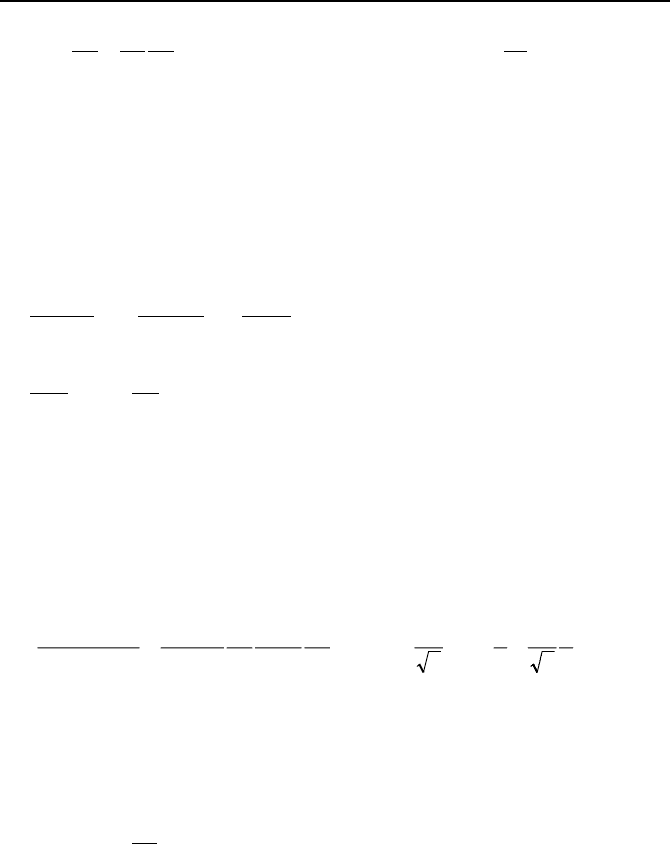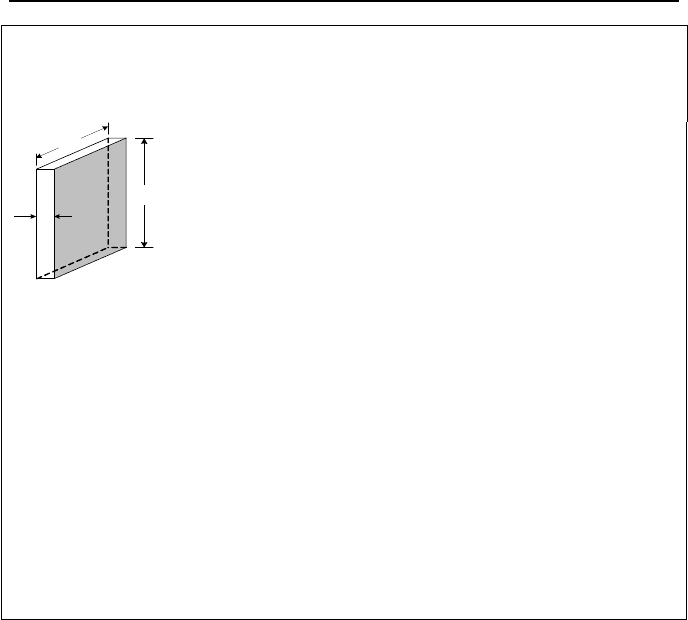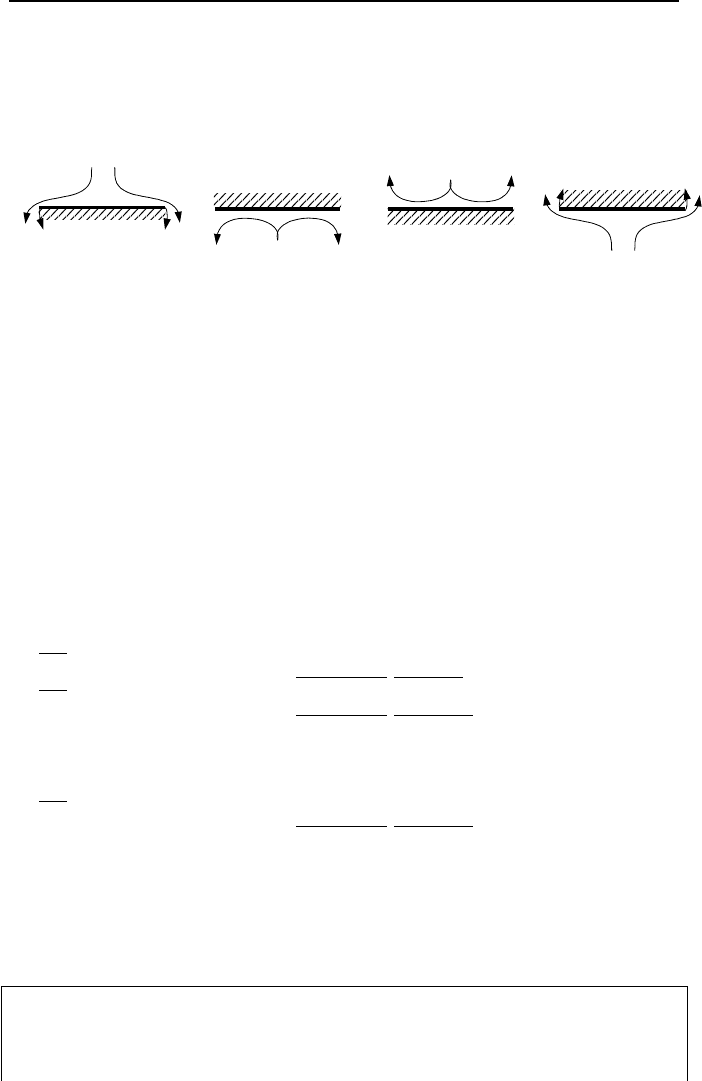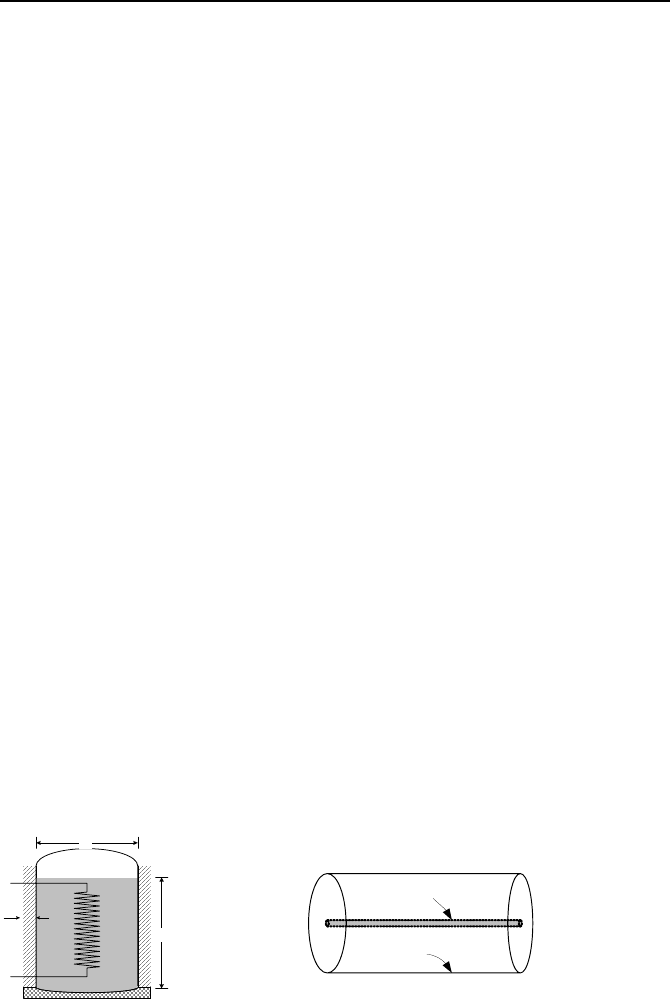Massoud M. Engineering Thermofluids: Thermodynamics, Fluid Mechanics, and Heat Transfer
Подождите немного. Документ загружается.


552 IVc. Heat Transfer: Free Convection
[][]
)(Gr
2
/)4/Gr()()4/Gr(4
ȥȥ
2/14/14/1
ξξ
ξ
ξ
f
x
v
xfv
yy
V
xxxx
′
=
′
=
∂
∂
∂
∂
=
∂
∂
=
To obtain V
y
, we may either use V
y
= –∂ψ/∂x or use the continuity Equa-
tion IIIa.3.13-1 to find V
y
in terms of
ξ
and f(
ξ
) as V
y
= vc
1
x
–1/4
[
ξ
f’(
ξ
) – 3f(
ξ
)].
Having found V
x
and V
y
in terms of
ξ
and f(
ξ
), Ostrach introduced a dimensionless
temperature
θ
= (T − T
f
)/(T
s
− T
f
). Substituting for V
x
, V
y
, T
s
, and their related de-
rivatives in terms of
ξ
f(
ξ
), and
θ
, the set of partial differential equations given by
Equations IIIa.3.13-1, IIIa.3.20-1, and IVc.2.1 are reduced to the following set of
two ordinary differential equations:
0
)(
2
)(
3
)(
2
2
2
3
3
=+
¸
¸
¹
·
¨
¨
©
§
−+
θ
ξ
ξ
ξ
ξ
ξ
ξ
d
df
d
fd
f
d
fd
0Pr3
2
2
=+
ξ
θ
ξ
θ
d
d
d
d
f
This set is subject to the following boundary condition. For
ξ
= 0, f = df/d
ξ
= 0
and
θ
= 1. The other boundary condition is for
ξ
→∞, df/d
ξ
= 0 and
θ
= 0. We do
no expect to find an analytical solution to the above set of coupled non-linear sec-
ond and third order differential equations. But we know that
θ
’(0) = −f(Pr) is a
part of the solution since it is the dimensionless temperature gradient at the wall.
We now tie this condition to the heat transfer coefficient through the heat transfer
gradient at the wall:
(Pr)Gr
2
11
Gr
2
1
)0('
)0(
)/(
4/14/1
0
f
x
k
x
k
dy
dș
ș
T
TT
k
TT
yTk
h
xx
fsfs
=−=
∂
∂
∂
∂
−
−
=
−
∂∂−
=
θ
ξ
ξ
The above relation can be written in terms of Nu = f(GrPr) = f(Ra). Seemingly,
we obtained an analytical solution for this problem. However, f(Pr) is yet to be
determined. One way to find this function is to solve the above set of differential
equations numerically, plot
θ
= f(
ξ
) and find the slope of the curves in such plots.
Ostrach obtained numerical solutions for f(
ξ
) and
θ
in terms of Pr number. An
empirical fit to the results of Ostrach solution is f(Pr) = 0.676Pr
1/2
(0.861 + Pr)
−1/4
.
Hence, Nu and
Nu becomes:
[]
4/1
4/1
Pr)/861.0(1Ra478.0Nu
−
+=
xx
IVc.2.2
[]
4/1
4/1
Pr)/861.0(1Ra637.0Nu
−
+=
LL
IVc.2.3
All properties are evaluated at the film temperature except for
β
which for gases is
found at T
f
.

3. Empirical Relations 553
Example IVc.2.1. A vertical plate is maintained at 40 C. This plate is placed in a
quiescent hot air at 114 C, find the rate of heat transfer to the plate. Use L
plate
=
0.3 m, b
plate
= 0.42 m,
δ
= 1 mm, and P
air
= 1 bar.
L
b
δ
Solution: We first find the air properties from Table A.IV.4 at T
av
= (40 + 114)/2
= 350 K:
v = 20.92E-6 m
2
/s, k = 0.03 W/m·C, Pr = 0.7,
β
= 1/T
f
= 1/(114 + 273) = 1/387 =
2.584E-3 K
-1
.
Ra
L
= Gr
L
Pr = [g
β
(T
s
– T
f
)L
3
/v
2
]Pr
= [9.81 × (2.584E-3) × (114 – 40) × 0.3
3
/(20.92E-6)
2
] × 0.7 = 1.157E8
[]
4/1
4/1
Pr)/861.0(1Ra637.0Nu
−
+=
LL
= 0.637 × (1.157E8)
0.25
× [1 + (0.861/0.7)]
–0.25
= 54
h = Nu
L
× k/L = 54 × 0.03/0.3 = 5.4 W/m
2
·C (≈1 Btu/h·ft
2
·F)
Q
= hA(T
f
– T
plate
) = 5.4 × (0.3 × 0.42) × (114 – 40) = 50 W.
Heat transfer to both sides is 2 × 50 = 100 W.
3. Empirical Relations
While the foregoing derivation was for a simple case of laminar flow over flat
plate, we expect the same functional relationship Nu = f(Ra) for more complicated
cases involving turbulent flow over inclined flat plates, cylinders, and spheres. In
free convection, the transition between laminar to turbulent flow takes place at a
critical Ra = 1E9 for vertical plates. Due to the inherent complexities of turbulent
flow coupled with the fact that the surface may be oriented at angles or being
curved, the only solution we find is in the form of empirical correlations. Such
correlations are generally devised for the entire range of the Ra number.
3.1. Flow over Vertical Plates and Cylinders
Isothermal vertical plate: For flow over an isothermal vertical plate, Chur-
chill and Chu recommend:

554 IVc. Heat Transfer: Free Convection
()
[]
2
6/1
0.296-
5625.0
RaPr/492.01387.0825.0Nu
¿
¾
½
¯
®
++=
L
L
1.0E-1 < Ra < 1.0E12
IVc.3.1
Isothermal vertical cylinders: Equation IVc.3.1 is also applicable to isother-
mal vertical cylinders provided that (D/L)
Cylinder
≥ 35/
4/1
Gr
L
. Fluid properties
should be evaluated at T
FIlm
= (T
s
+ T
f
)/2 but
β
is found at T
f
.
Example IVc.3.1. A radiator consists of 36 vertical plates, each maintained by an
electrical element at a temperature of 62 C, to heat a room at 12 C. The plates
have a height of 45 cm, a width of 10 cm, and a thickness of 10 mm. Find the rate
of heat transfer from this radiator. Pressure in the room is atmospheric.
Solution: We first find the air properties from Table A.IV.4 at T
av
= (12 + 62)/2 =
37 C = 310 K:
v = 16.89E-6 m
2
/s, k = 0.0274 W/m·C, Pr = 0.706,
β
= 1/T
f
= 1/(12 + 273) =
3.508E-3 K
-1
.
Gr
L
= g
β
(T
s
– T
f
)L
3
/v
2
= 9.81 × (3.508E-3) × (62 – 12) × 0.45
3
/(16.89E-6)
2
=
5.484E8
Ra
L
= Gr
L
Pr = 5.484E8 × 0.706 = 3.87E8
For isothermal vertical plates, we use Equation IVc.3.1:
Nu
L
= {0.825 + 0.387[1 + (0.492/0.706)
0.5625
]
–0.296
(3.87E8)
0.16667
}
2
= 91.78
h = Nu × k/L = 91.78 × 0.0274/0.45 = 5.59 W/m·C (≈ 1 Btu/h·ft
2
·F)
Q
= N
plates
× hA(T
plate
– T
f
)
A
plate
= 2(L × b + b ×
δ
+ L ×
δ
)
A
plate
= 2(0.45 × 0.10 + 0.45 × 0.01 + 0.1 × 0.01) = 0.101 m
2
Q
= 36 × 5.59 × 0.101 × (62 – 12) = 1 kW.
Vertical plates and cylinders with constant heat flux: For flow over vertical
plates and cylinders in constant heat flux, Churchill & Chu correlation is:
[]
0)Gr(PrPr)/492.0(167.0Nu68.0Nu
25.0*25.0
445.0
5625.0
25.025.1
=+−−
−
L
LL
1.0E-1 < Ra < 1.0E12 IVc.3.2
where in Equation IVc.3.2,
)/(Nu TkLQ
s
L
∆=
with T∆ calculated from
])2/([
fs
TLTT −=∆ . Fluid properties should be evaluated at T
Film
= (T
s
+ T
f
)/2
but
β
is found at T
f
.

3. Empirical Relations 555
3.2. Flow over Horizontal Plates and Cylinders
Heat transfer coefficient in free convection over horizontal plates strongly depends
on the orientation of the plate with respect to temperature as the flow pattern de-
pends on the side of plate under consideration (Figure IVc.3.1).
T
s
< T
f
T
s
< T
f
T
s
> T
f
T
s
> T
f
(a) (b) (c) (d)
Figure IVc.3.1. Horizontal plates in free convection
Consider for example a cold horizontal flat plate in a hotter fluid (a). Fluid on
the top would move over the plate, get cooler, and would flow downward from the
side of the plate. On the other hand, in case (b), fluid moves underneath the plate,
gets cooler and freely rushes downward leading to a more effective heat transfer in
case (b) than in case (a). A similar situation exits for cases of (c) and (d) where
cooler fluid moves over the plate, gets warmer and freely moves upward where in
case (d), fluid moves underneath the plate, gets warmer, and can move upward
only when it reaches the edges of the plate.
Isothermal horizontal plates: For the more effective cases of (b) and (c), the
average Nu number originally suggested by McAdams, for the indicated ranges of
the Rayleigh numbers, should be calculated from:
0.25
N
u0.54Ra
L
L
=
1.0E4 ≤ Ra
L
≤ 1.0E7 IVc.3.3
0.33
N
u0.15Ra
L
L
=
1.0E7 ≤ Ra
L
≤ 1.0E11 IVc.3.4
For the less effective cases of (a) and (d), the average Nu number may be calcu-
lated from
0.25
N
u0.27Ra
L
L
=
1.0E5 ≤ Ra
L
≤ 1.0E10 IVc.3.5
In these correlations, the characteristic length L used in the calculation of the
Grashof number is found from L = A/P where A is the surface area and P the pe-
rimeter. Fluid properties in Equations IVc.3.3 through IVc.3.5 should be evalu-
ated at the T
Film
= (T
s
+ T
f
)/2.
Example IVc.3.2. An air-cooled compressor uses 15 thin, annular fins. When
the engine is operating at steady state, each fin is at an average temperature of 200
F. The ambient is at 1 atm and 60 F. The inside and the outside diameters are 6 in
and 1.6 ft, respectively. Find the steady state rate of heat transfer.

556 IVc. Heat Transfer: Free Convection
Solution: We first find the air properties from Table A.IV.4 at T
av
= (200 + 60)/2
= 130 F = 590 R:
v = 1.72E-4 ft
2
/s, k = 0.016 Btu/h·ft
2
·F, Pr = 0.705,
β
= 1/T
f
= 1/590 = 0.00169 R
-1
.
A
plate
=
π
(D
2
– d
2
)/4 =
π
[1.6
2
– (6/12)
2
]/4 = 1.81 ft
2
P
plate
=
π
D =
π
× 1.6 = 5 ft
L
characteristic
= A/P = 1.81/5. = 0.362 ft
Gr
L
= g
β
(T
s
– T
f
)L
3
/v
2
= 32.2 × 0.00169 × (200 – 60) × 0.362
3
/(1.72E-4)
2
=
12.22E6
Ra
L
= Gr
L
Pr = 12.22E8 × 0.705 = 8.61E6
For isothermal horizontal plates with Ra
L
= 8.61E6, we use Equation IVc.3.3:
Nu
L
= 0.54 × (8.61E6)
0.25
= 29.25
h = Nu × k/L = 29.25 × 0.016/0.362 = 0.77 Btu/h·ft
2
·F
Q
= N
plates
× hA(T
plate
– T
f
) = 15 × 0.77 × 1.81 × (200 – 60) = 2927 Btu/h
= 0.86 kW. Total rate of heat transfer is 1.56 kW.
Isothermal horizontal cylinders: For horizontal cylinders, Churchill and Chu
recommend the following correlation:
()
[]
2
296.0
5625.0
1667.0
Pr/559.01Ra387.06.0Nu
¿
¾
½
¯
®
++=
−
DD
1.0E-5 < Ra < 1.0E12
IVc.3.6
The characteristic length for the calculation of the Grashof number is the cylinder
diameter. Fluid properties should be evaluated at T
av
= (T
s
+ T
f
)/2 but
β
is found
at T
f
.
Example IVc.3.3. Cold water is flowing in a thin-wall tube, maintaining the tube
wall temperature at 14 C. The ambient air is at 40 C. Find the rate of heat transfer
to the tube wall. D
tube
= 6 cm, L
tube
= 4 m.
Solution: Finding the air properties from Table A.IV.4 at T
av
= (14 + 40)/2 = 27
C = 300 K:
v = 15.89E-6 m
2
/s, k = 0.0263 W/m·C, Pr = 0.707,
β
= 1/T
f
= 1/(40 + 273) =
3.195E-3 K
-1
.
Gr
L
= g
β
(T
s
– T
f
)L
3
/v
2
= 9.81 × (3.1955E-3) × (40 – 14) × 0.06
3
/(15.89E-6)
2
=
0.697E6
Ra
L
= Gr
L
Pr = 0.697E6 × 0.707 = 493,000
For isothermal horizontal cylinders, we use Equation IVc.3.6:
Nu
L
= {0.6 + 0.387 × 493,000
0.1667
[1 + (0.559/0.707)
0.5625
]
–0.296
}
2
= 11.94
h = Nu × k/L = 11.94 × 0.0263/0.06 = 5.23 W/m·C
Q
= hA(T
plate
– T
f
) = 5.23 × (
π
× 0.06 × 4) × (40 – 14) = 102.6 W.

Questions and Problems 557
Spheres: For spheres immersed in fluids, having Pr ≥ 0.7, Churchill (1983)
recommends the following correlation:
()
[]
4445.0
5625.0
25.0
Pr/469.01Ra589.02Nu
−
++=
DD
Ra
L
≤ 1.0E11 IVc.3.7
The characteristic length for the calculation of the Grashof number is the cylinder
diameter. Fluid properties should be evaluated at T
Film
= (T
s
+ T
f
)/2 but
β
is found
at T
f
.
Example IVc.3.4. Compare the heating of a spherical metal, 6 cm in diameter, in
water and in air. Water is saturated at 100 C. Air is also at 100 C and 1 atm. The
metal is at 20 C.
Solution: The rate of heat transfer in the two mediums is proportional to:
AirAir
WaterWater
Air
Water
Air
Water
k
k
TAh
TAh
Q
Q
Nu
Nu
=
∆
∆
=
The average temperature is both medium is T
Film
= (20 + 100)/2 = 60 C. The air
and water properties are:
Medium v (m/s
2
) Pr k (W/m·C)
β
(1/K)
Air 18.900E-6 0.708 0.0285 0.003003
Water 0.4748E-6 3 0.6507 0.000529
Ra
Air
= [g
β
(T
s
– T
f
)L
3
/v
2
]Pr = [9.81 × 0.003003 × (100 – 20) × 0.06
3
/(18.90E-6)
2
]
× 0.708 = 1.00E6
Ra
Water
= [g
β
(T
s
– T
f
)L
3
/v
2
]Pr = [9.81 × 0.005290 × (100 – 20) × 0.06
3
/(0.4748E-
6)
2
] × 3 = 1.197E10
Nu
Air
= 2 + 0.589 × (1E6)
0.25
× [1 + (0.469/0.708)
0.5625
]
–0.4445
= 35.4
Nu
water
= 2 + 0.589 × (1.197E10)
0.25
× [1 + (0.469/3)
0.5625
]
–0.4445
= 311.8
The rate of heat transfer in water is (311.8/35.4) × (0.6507/0.0285) = 201 times
faster.
QUESTIONS
− What mode of heat transfer governs the oceanic and the atmospheric motions?
− The heating system of a tall building consists only of a boiler, located in the
basement, the radiators (located on each floor), and the pipe runs. What mode
of heat transfer is used in this design?
− What is the difference between Nu and Nu , between Gr and Gr*, and between
Re and Ra?
− What is the value of the Ra number for the transition for the free convection
boundary layer from laminar to turbulent?
− What is the characteristic length? How is it calculated in a horizontal cylinder?

558 IVc. Heat Transfer: Free Convection
− Consider free convection over a horizontal plate with T
s
> T
f
. Compare the heat
transfer from the top of the plate with that from the bottom of the plate. Which
heat transfer is more efficient?
PROBLEMS
1. A flat plate, maintained at 250 C is placed vertically in air at a pressure of 1 bar
and temperature of 20 C. The plate height and width are 20 cm and 10 cm. Find
the rate of heat transfer to this plate. [Ans.: 64 W].
2. Consider two identical flat plates both maintained at 400 K. These plates are
placed vertically into tow large containers. One plate is placed in a container full
of air at 300 K and 1 atm and the other plate in a container full of carbon dioxide
at 300 K and 1 atm. Find the ratio of the Grashof numbers Gr
air
/Gr
CO2
.
3. Consider two identical flat plates both maintained at 400 K. These plates are
placed vertically into tow large containers. One plate is placed in a container full
of air at 300 K and 1 atm and the other plate in a container full of carbon dioxide
at 300 K and 1 atm. Find the ratio of the heat transfer coefficients h
air
/h
CO2
and the
rate of heat transfer
2COair
/ QQ
.
4. For a flat plate, the transition from the free convection boundary layer to the
free convection turbulent boundary layer takes place at a Rayleigh number of
about Ra = 1E9. A flat plate at 70 C is placed in a colder medium at 27 C. Find
the location on the plate where this transition takes if the plate is placed in:
a) air, b) Ammonia, c) water. All fluids are at 1 atm.
5. A flat plate of glass, having a height of 1 ft is heated to 200 F in an annealing
furnace. The plate is then removed and placed vertically in a room at 60 F and
14.7 psia to be air cooled. Find the initial rate of heat transfer from the glass plate.
6. A radiator consists of 15 vertical plates, each maintained by an electrical ele-
ment at a temperature of 65 C. to heat a room at 15 C. The plates have a height of
50 cm, a width of 12 cm, and a thickness of 16 mm. Find the rate of heat transfer
from this radiator. Pressure in the room is atmospheric.
7. Two identical plates (A and B), heated to 40 C, are placed in quiescent air at
15 C and 1 atm to be air-cooled. Plate A is hanged vertically and the plate B is
placed horizontally. Both plates are cooled from both sides. Assuming no ther-
mal radiation and only free convection heat transfer, which plate cools faster?
8. An air-cooled engine uses 20 thin, horizontal fins. When the engine is operat-
ing at steady state, each fin is at an average temperature of 240 F. The ambient is
at 1 atm and 60 F. The inside and the outside diameters of each annular fin are 8
in and 2 ft, respectively. Find the steady state rate of heat transfer.
9. A small transformer is placed in a metal box. The box has a height of 10 cm,
depth of 0.75 m, and width of 1 m. There is no heat transfer from the bottom of
the box and from the four insulated sides, as heat is dissipated only from the top of

Questions and Problems 559
the box. The ambient air is at 20 C at 1 atm. The rate of heat transfer to be dissi-
pated is 0.4 kW. Find the temperature of the top of the metal box.
10. The air conditioning duct in a house is 60 m long. The duct cross section is a
rectangle with a height of 35 cm and width of 75 cm. The duct is bare and ex-
posed to air at 18 C. Find the total rate of heat loss if the average surface tempera-
ture of the duct metal is 35 C.
11. A block of steel is uniformly heated from inside to maintain its temperature at
100 C. The block is a rectangular parallelepiped. The base of the block is a 3 cm
by 3 cm square and the height of the block is 6 cm. We place this block in air at
25 C. Find the rate of heat loss from this block by natural convection.
12. A horizontal steam line carries saturated steam at a rate of 6.0E6 lbm/h. The
steam line has a diameter of 2.67 ft, a wall thickness of 2 in, and a length of 150 ft.
Accounting for the steam pressure drop in the pipe, steam may be considered satu-
rated at an average pressure of 800 psia. The pipe is insulated with a thickness of
7 inches. Find the rate of heat loss to the ambient at 23 C. The emissivity of the
insulation is 0.7. Other data include P
ambient
= 1 atm, k
s
= 10 Btu/h·ft·F, k
i
= 0.7
Btu/h·ft·F. The ambient air is quiescent.
13. Slurry at a rate of 110 lbm/h and 110 F is pumped through 2 in inside diame-
ter pipe. After traveling in a unheated length of the pipe, the slurry enters a 3 ft
long heated section where the wall of the pipe is maintained at 190 F. Find the
average temperature of the slurry leaving the heated section. Thermal properties
of slurry are as follows
ρ
= 70 lbm/ft
3
,
µ
= 150 lbm/h·ft, c = 0.4 Btu/lbm·F, and k
= 0.5 Btu/h·ft·F.
14. A large tank of diameter D contains water to height L, as shown in the figure.
The tank is insulated with a layer of insulation, having a thickness of
δ
i
. The tank
wall thickness is
δ
s
. The water bulk temperature is maintained at T
fi
while the am-
bient temperature is T
fo
. Use the given data to find the rate of heat that is trans-
ferred to water at steady state conditions.
Data: D = 8.04 ft (2.45 m), L = 32.8 ft (10 m),
δ
s
= 4 in, (10.16 cm),
δ
i
= 5 in
(12.7 cm), P
fi
= 2250 psia (15.51 MPa), T
fi
= 500 F (260 C), P
fo
= 1 atm, T
fo
= 85 F
(29.5 C), k
s
= 10 Btu/h·ft·F, k
i
= 0.8 Btu/h·ft·F.
δ
L
D
Fuel rod
Canister
Problem 14 Problem 15
15. A spent fuel rod is placed in a canister. A vacuum pump is used to remove all
air and establish vacuum in the canister. The surface temperature of the rod must

560 IVc. Heat Transfer: Free Convection
not exceed 392 F (200 C) while the temperature of the canister wall must remain
at 151 F (66 C). For a heat transfer coefficient of 2 Btu/h·ft
2
·F (11.4 W/m
2
·C) find
the ambient temperature. Ignore conduction heat transfer between the rod and the
canister.
ε
canister
= 0.6.
16. A solid sphere made of polished copper has a diameter of 2 cm and is at 100
C. We now expose the solid sphere to are at 50 C and 1 atm. Use the lumped ca-
pacitance method to plot the temperature of the solid sphere versus time after five
minutes of exposure. The air is quiescent.
17. A spent fuel rod is placed in a canister. A vacuum pump is used to remove all
air and establish vacuum in the canister. The surface temperature of the rod must
not exceed 392 F (200 C) when the temperature of the ambient is at 40 C (104 F).
For a heat transfer coefficient of 1.5 Btu/h·ft
2
·F (8.5 W/m
2
·C) find the canister
wall temperature. Ignore conduction heat transfer between the rod and the canis-
ter.
ε
= 0.6.
18. A spent fuel rod is placed in a canister. A vacuum pump is used to remove all
air and establish vacuum in the canister. The surface temperature of the rod must
not exceed 302 F (150 C) when the temperature of the ambient is at 40 C (104 F).
Find the canister wall temperature. Ignore conduction heat transfer between the
rod and the canister.
ε
= 0.6.
19. A longitudinal fin of rectangular profile (Figure IVa.8.6) made of aluminum is
used to dissipate heat from a hot surface. Find the rate of heat transfer from this
fin. Data: T
b
= 125 C, T
f
= 27 C, L = 20 cm, b = 14 cm,
δ
= 1 cm. [Hint: Assume
a reasonable value for h to find T(x = L/2) from Equation IVa.8.7 and iterate until
the convergence criterion is met].
20. A well insulated water tank contains 100 lit of water at 27 C. We want to heat
the water to 90 C. For this purpose we place a coil made of copper with an out-
side diameter of 1.2 cm in the water. The coil carries steam at 115 kPa. Ignore
the thermal resistance of the condensing steam. Find a) the required heating time
and b) the amount of steam condensed in the coil.
21. A horizontal pipe delivers steam at 1 MPa and a rate of 100 kg/s to a steam
turbine. The pipe (O.D. = 11.5 cm and I.D. = 96.5 cm) is made of carbon steel.
You may assume that the air and the walls of the turbine building are both at 20 C.
Use an emissivity of 0.81 for the pipe surface to estimate the rate of heat loss, per
unit length of the pipe, due to the free convection and thermal radiation mecha-
nisms.

1. Definition of Thermal Radiation Terms 561
IVd
.
. Thermal Radiation
Thermal radiation is perhaps the most interesting mode of heat transfer, as it does
not require a material medium. The recognition of this interesting feature, which
today is commonplace, has a long history. In Chapter VII, we have discussed sci-
entists’ efforts to unify physical concepts. Up to about 100 years ago, these efforts
had been focused on explaining every phenomenon in terms of two independent
branches of science. First, classical mechanics for explaining the behavior of par-
ticles based on the Newton laws and electromagnetism for explaining the behavior
of waves based on Maxwell’s equations. The most challenging task was explain-
ing the nature of light, which was thought to behave only as a wave. However, if
light behaved only as an electromagnetic wave, how could then it travel through
empty space? While filling the vacuum with fictitious ether provided a temporary
solution, it was the development of modern physics, based on quantum mechanics,
which allowed description of particles and waves as two distinct modes of behav-
ior. In quantum mechanics, a wavelength is defined for particles. Max Planck in-
geniously expressed energy of particle-like electromagnetic radiation in terms of
wave frequency. Since wavelength is related to the speed of the particle through
frequency, we conclude that the shorter the wavelength, the more energetic the
particle. The term radiation encompasses a wide range of wavelengths in the elec-
tromagnetic spectrum. In this chapter we limit our discussion to thermal radiation,
which covers only radiation emitted as a result of the temperature of a substance.
We consider surfaces emitting or receiving radiant energy. We will see that radia-
tion heat transfer is treated differently because the radiant energy is both direc-
tional and wavelength dependent.
1. Definition of Thermal Radiation Terms
1.1. Definitions Pertinent to Wavelength
Electromagnetic spectrum refers to such energetic radiation as cosmic rays on
the one-side and such low energy radiation as radio waves and TV signals, on the
other. Some types of radiation can be seen, such as light, some can be felt, such as
heat, and some can only be detected by sensitive instruments.
Wavelength (µm)
1E-10 1E-4 1E-3 1E-2 1E-1
1
1E1 1E2 1E3
1E4
1E5
Hertzian Waves
Red
Yellow
Green
Blue
Violet
Infrared
Ultraviolet
0.4
0.7
Visible Light
γ Rays
X Rays
Thermal Radiation
1E10
Radar, Television, Radio
Electric Power
Cosmic Rays
Figure IVd.1.1. Depiction of the electromagnetic spectrum on a log scale
